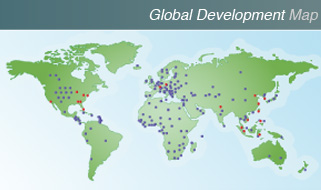-
“Let a thousand flowers bloom”
Posted May 23, 2012
“Let a thousand flowers bloom”
- Chairman Mao
This now-famous quote is actually a misinterpretation of what Mao really said, which apparently was “let a hundred blossoms flower.” He made this statement in a speech in 1957 welcoming the Chinese intelligentsia to a conference in which he invited open criticism of the regime. Such diversity of thought, he said, was the only way to further art, politics and science. After the conference he summarily executed all of the dissidents who showed up. There is more than one lesson to be learned here, perhaps.
I am writing about a recent article in Vanity Fair which lambasted the pharmaceutical and biotech industries for “going abroad” to conduct clinical trials. Although poorly reasoned, the authors made an impassioned argument about the possible dangers that could arise from clinical trials conducted outside of the “traditional” big pharma/academic/FDA process. Of course, the authors also maintained the somewhat contradictory notion that this traditional process itself is so rife with conflict and evil characters lurking in every corner that it isn’t worth much either. In the end, though, their loathing for the industry eventually won out. The article pretty much declares that all foreign trials are a sham and nothing but a “cover” for bad science and even worse medicine. I think they wanted to conclude by saying “couldn’t we please have the FDA police the entire world to make it safe for Americans to take drugs” – except they can’t bring themselves to admit the FDA actually gets it right.
Not withstanding this ridiculous article, there is a serious debate going on in the real world about international standards and patient protection. The one point the authors do get right is that there is an explosion of trials throughout the developed and developing world. What they fail to understand is that this is a good thing. Aside from the obvious fact that the “old world” trial infrastructure literally could not conduct the thousands of trials ongoing outside of the “old world,” there is something more important at work here. There has been an explosion of science in the past decade, brought on by the decoding of the genome, the exponential increase in computer power, and the democratization of knowledge via the Internet.
The authors actually start their diatribe by bemoaning the fact that all good research isn’t done at a handful of established academic institutions as though that would somehow assure purity and brilliance. Certainly, before the Internet, there was a time when a great majority of the world’s top thinking was done in such sanitized labs. No one else really knew what everyone else knew, and knowledge, like power, was horded. The slow and steady pace of publication was the only way knowledge was disseminated to the outside. It was truly a closed club.
But that has all changed. Now when someone at UC San Diego, for example, does something, figures something out, or “knows” something, scientists from Mexico City to Palermo know it almost at the same time. And in this Wiki-world we live in, the hive begins to think about things and acts on those thoughts. To imply, as these magazine authors did, that clinical trials cannot be carried out with just as much quality and dedication to science in LaPaz as they can be carried out in Los Angeles, is either blatantly racially biased, or just the product of third-rate, “old world” thought. (Granted, if pressed, they would likely not admit that the trials carried out in L.A. were any good either).
Simply put, the biggest problem we have in the industry today is not that the world of medicine has left the imaginary comfort of the “Father Knows Best” universe. It is that the institutions established to move medical science from the bench to the bedside are too slow and too expensive to nurture the innovation and breakthroughs which today’s science can and should enable.
Yes, there are important ethical issues that must be dealt with regarding research on human subjects. And, yes, the faster one goes and the more open a system is, the more there is potential for abuse. But the solution is to create new institutions and/or empower old ones with new tools. It is not to cling to some old Colonial notion that only the educated man from Oxford or Harvard can do “real” science. Or to somehow think that our institutional judgments on weighing risk and benefit are the only judgments that can be of value.
There are places in the world where the regulatory authorities conclude that treatments for incurable, fatal diseases, or those that cause intractable pain for instance, should go forward at a much faster pace simply because of those issues. Safety is still safety, and efficacy is still efficacy, they are not one thing in the U.S. and another thing in Latin America, or in Eastern Europe. Shoddy science is shoddy science everywhere and needs to be condemned openly and quickly. No one is arguing for less rigorous science.
But somehow, someway, we need to move to a place where rigorous science doesn’t mean rigor mortis in pace. Somehow, someway, we need to encourage and nurture innovation in medical treatments, not simply defend the status quo. The place to start is with incurable, fatal, intractable serious diseases, like ALS. And the way is to allow quicker, broader access to experimental therapies for these patients, with full disclosure and transparency; after they have been shown to be safe: full stop (not after they have demonstrated safety and efficacy). There are so many new technologies and new targets pushing for attention and resources, and offering hope to many who have none. It is time to let a hundred blossoms flower. Let’s hope they don’t shoot the messengers.






